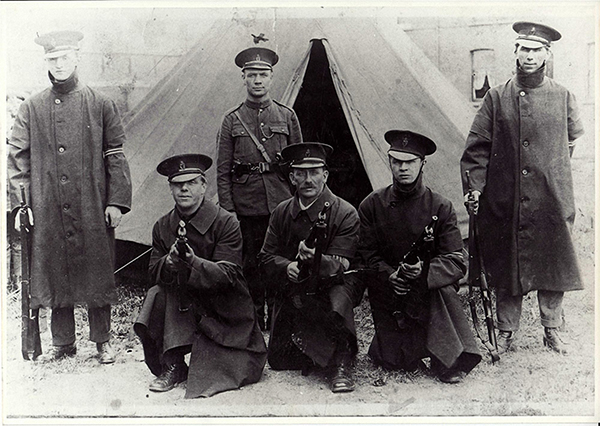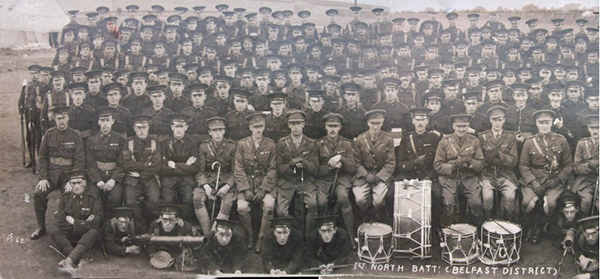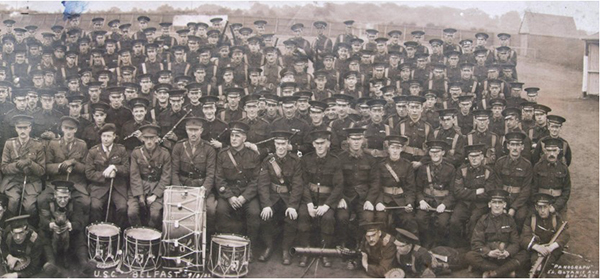The Ulster Volunteer Force in police uniform
Published in Features, Issue 2 (March/April 2021), Volume 29The creation of the Ulster Special Constabulary, 1920
By Seán Bernard Newman

Above: Sir Wilfrid Bliss Spender—sent to Belfast by Sir James Craig in 1920 to re-form the UVF, which became the USC in late 1920/early 1921. (NPG)
“As an official and authorised force, the USC gave Craig the means to defend the border, consolidate Ulster unionist power and guarantee Northern Ireland’s long-term future.”
The Ulster Special Constabulary (USC) is a fundamental institution in Northern Ireland’s history. Historians cannot overstate its influence within Ulster unionist politics, society and culture during the early years of partition. When the Better Government of Ireland Act (1920) drew a precarious line on the map of the island—creating two new states—there was no guarantee that one or both would survive. The Northern Ireland state’s endurance beyond the 1920s owes a great deal to the USC’s activities. Some Specials showed determination and commitment to the cause of ‘God and Ulster’, while others carried out cowardly atrocities with an eye on allowances and pay.
While some see the creation of the USC—and Northern Ireland’s security policy in general—as a Westminster-based initiative, research shows that James Craig’s government and the Ulster unionist movement pushed for, organised and manned the force locally. While there remains a high narrative of Westminster intrigue and decision-making, it is much more accurate to understand the USC in their formation in the towns and villages of Northern Ireland. Events and motivation in the north-east, not Westminster, drove Northern Ireland’s security policy and the USC’s creation.
Gestation
When UK Prime Minister David Lloyd George agreed to create an armed special constabulary in Ulster in September 1920—to begin recruitment the following November—it merely formalised the reality that Protestant paramilitary forces already marched in the cities, villages and townlands of Ulster.
Formed in January 1913 to resist the implementation of Home Rule, the Ulster Volunteer Force (UVF) numbered over 110,000 volunteers in 1914. The Larne gunrunning in April 1914 armed the UVF with 25,000 rifles and 3,000,000 rounds of ammunition, but the force disbanded—at least officially—at the outbreak of the First World War. Recent research shows that the UVF carried on during the war. It slept with one eye open and, rather than disbanding, it even offered to supply its smuggled rifles to Crown forces and to assume responsibility for policing Ulster during the Easter Rising. At the signing of the Armistice, the volunteers—although younger men with no war experience enlisted in the USC too—returned to Ulster as hardened veterans of the war. When nationalists made gains in local elections in Derry City and the IRA came to the negotiating table after the Truce, the UVF stood ready to fend off any republican advances.
Craig’s nightmare
Ulster unionist leader James Craig harboured twin fears: firstly, armed republicans crossing the border or, worse still, home-grown nationalists rising from within the new state; secondly, ‘Bolsheviks’ and ‘socialists’ organising among working-class Protestants in Belfast’s shipyards and factories, and in textile mills across Ulster. If those forces combined into a cross-community class-conscious movement, all was lost. Craig needed to bottle the aggression and violence of the Ulster unionist working classes—seen so vividly in the shipyard expulsions and numerous sectarian riots of the time—and direct it against nationalists. He aimed to keep the ‘rank and file’ under discipline and use them to repress any nationalist threat to the new state. With its personnel and organisation still intact, the UVF offered Craig the perfect means to do just that.
From the summer of 1920 the UVF—its personnel somewhat changed since 1914—re-formed and reactivated. In Fermanagh, future prime minister Basil Brooke (later Lord Brookeborough) organised the workers on his estate and in the local border community into the ‘Fermanagh Vigilance Force’ both to fend off border raids from republicans and to keep Ulster unionist ‘hotheads’—to use his own words—from taking matters into their own hands. In Lisbellaw ‘Carsonite Volunteers’ formed an ‘Orange patrol’ and in June conducted a firefight with ‘raiders’, using Larne-era rifles. In County Tyrone, Ulster unionist leaders formed a vigilance group organised by UVF officers that acted independently of Crown forces. Founded with three classes—‘A’, ‘B’ and ‘C’ (and ‘C1’ in 1922)—the USC mirrored the organisation of that earlier Tyrone force into ‘No. 1 Category’, ‘No. 2 Category’ and ‘No. 3 Category’. By August Lisburn District Council had responded to sectarian violence and raised an unofficial ‘corps of special constables’ numbering around 800.
In Belfast ‘vigilance committees’ formed in the shipyards, factories and textile mills to stop expelled nationalists and ‘rotten Prods’ returning to work. Concerned at the lawlessness of the ‘vigilance committees’, a Revd Redmond organised some of the vigilantes into unarmed ‘Peace Pickets’. The lord mayor of Belfast began to organise a ‘Special Force’ to assist the military—despite the military’s reluctance to accept their assistance. With members of the ‘Lord Mayor’s Special Force’ required to take an oath of allegiance, nationalists were implicitly excluded, as they were from all the other groups mentioned (except Brooke’s in Fermanagh). UVF commander-in-chief—and future Northern Ireland cabinet secretary—Wilfrid Spender arrived in Belfast in July 1920 to organise the UVF in its new guises into a single and cohesive force. In August he committed the Belfast UVF to man the ‘Lord Mayor’s Special Force’. He considered recruitment from outside the UVF to be shameful and a stain on the organisation’s honour, commitment and loyalty.
Spender’s ‘Special Service Force’
In August Spender drew up plans for a ‘Special Service Force’ (SSF) to incorporate the various vigilance groups in Northern Ireland and fully mobilise the remainder of the UVF. Serving only in the province of Ulster, the SSF would reoccupy RIC barracks abandoned during the War of Independence and in areas where loyalists could not organise themselves into a reserve force; the SSF later became the ‘A’ Class. The second force, the ‘Special Reserve Force’ (SRF), would work in part-time shifts to support the SSF at a local level; the SRF became the ‘B’ Class. Spender initially failed to convince the imperial government to organise the remainder of the UVF as a third force to be armed and mobilised in the case of emergencies. With the SSF and SRF armed partly by the imperial government and partly from UVF caches from the Larne era, Spender ordered the leftover UVF weapons to be distributed to local UVF companies. There followed a vague mention of these groups forming a ‘C’ Class, which Spender used to organise any UVF volunteer unfit or unwilling to join the ‘A’ Class or the ‘B’ Class.

Above: A half-squad of ‘B’ Class Specials in the early days of the USC. The squad leader wears a khaki tunic and Sam Brown belt, while the others wear the caps, armlets and raincoats issued by the government during the recruitment period (1920–1). The weapons seem to be Larne-era rifles or carbines rather than government-issued Lee-Enfield rifles. (Police Museum, Belfast)
In the autumn, impatient at Lloyd George’s hesitancy to authorise the USC, Spender began to restructure the UVF. Recruitment forms asked volunteers to enrol in either ‘Category A’, ‘Category B’ or ‘Category C’ of the restructured UVF. Within weeks, however, Lloyd George relented. Unrest in the colonies and industrial disputes in Britain became the priority for a government keen to remove itself from Ireland. In November 1920 Categories ‘A’, ‘B’ and ‘C’ of the UVF became Classes ‘A’, ‘B’ and ‘C’ of the USC, as UVF members traded in their armbands for military uniforms dyed black and swapped their smuggled German and Italian rifles for War Office surplus Lee-Enfields. As an official and authorised force, the USC gave Craig the means to defend the border, consolidate Ulster unionist power and guarantee Northern Ireland’s long-term future.
The Specials on service
Thus the UVF Special Service Force became the Ulster Special Constabulary (USC). From 1 November 1920 poster bills appeared in each of what were to become Northern Ireland’s six counties (and two county boroughs) asking law-abiding men aged between 21 and 45 to come forward and enrol to assist the authorities in preventing crime and to maintain order. The number of Specials would equal the number of British troops that were pulled out of Northern Ireland.
Craig remained in London until the new year to carry on his role of junior minister in the Admiralty. He picked Sir Ernest Clark as assistant under-secretary for the Ireland Office responsible for Northern Ireland—the new position allowed the Northern Ireland government to deal directly with the Ireland Office in Whitehall without going through Dublin Castle, which wasn’t trusted. At their first meeting in Whitehall, Craig interrogated Clark on his commitment and loyalty to the new state. Once convinced of the civil servant’s reliability, Craig asked him where he ‘held Ulster’. A bemused Clark looked nonplussed until the soon-to-be prime minister of Northern Ireland crossed the room and dug his finger into Clark’s chest, spelling out the word ‘U-L-S-T-E-R’ across his ribs with his index finger before saying, ‘Where do you hold Ulster? In your heart!’ When he arrived in Belfast, Clark’s first order of business was to implement Spender’s USC plan.
Organised along the lines of the Black and Tans, the ‘A’ Class replaced and reinforced the regular RIC. Paid a full-time wage of £3-10s per week, which increased to £5-9s if all additional allowances were claimed, ‘A’ Specials received a further £25 annual bounty in lieu of a pension. ‘Barrack’ platoons manned deserted RIC stations and reinforced regular RIC patrols, much like the RIC Special Reserve (RICSR, a.k.a. Black and Tans), while ‘Mobile’ platoons, much like the Auxiliary Division RIC (ADRIC, a.k.a. Auxiliaries), deployed to wherever they were needed to combat nationalist threats. By June 1921, 5,500 ‘A’ Specials had enrolled.
The ‘B’ Class drew no comparisons to the Black and Tans in its organisational shape. ‘B’ Specials received no pay except for a £5 six-monthly bounty and 2/6 for each weekly patrol they performed in their district. ‘B’ Class allowances fluctuated over the years, with many cuts reversed in response to protests by the influential force. By 1924, 20,171 had enrolled in the ‘B’ Class. While the ‘A’ Class boast a less-than-unblemished record of sectarian violence and outrage, it is to the ‘B’ Class’s behaviour that the USC owes its infamous reputation. Part of a full-time force and usually accompanied and commanded by professional and experienced RIC officers, the ‘A’ Class were better trained and better disciplined. The stipulation that a professional RIC constable accompany ‘B’ Class patrols to maintain discipline was rarely enforced. Led by their own elected officers, the ‘B’ Class lacked discipline and, as an exclusively Ulster unionist paramilitary force,, regularly wreaked havoc and carried out atrocities in the feverishly sectarian climate of 1920s Northern Ireland. They proved a potent and effective weapon in the Ulster Unionist government’s quest to make the border permanent and to suppress any nationalist challenge—real or imagined—from within the state.


Above: ‘1st NORTH BATT: (BELFAST DISTRICT) U.S.C. BELFAST 9/3/23 “PANOGRAPH” 54 BOTANIC AVE BELFAST’ Note the Lewis guns, Lee-Enfield rifles and full uniforms of these ‘B’ Class USC. Many wear the ‘Pip, Squeak and Wilfred’ campaign and service medals as veterans of the First World War. The khaki-clad officers are likely ‘C1’ general headquarters staff or the military instructors secured by Solly-Flood from the War Office. (lennonwylie.co.uk)
We know little of the ‘C’ Class. It existed on paper but recruitment figures continued to be vague. Local magistrates charged with the swearing in of the ‘C’ Specials—the unfit and unwilling remainder of the UVF—complained that the men enlisted only to get an arms permit to shoot rabbits. ‘C’ Special membership came with no particular duty except to be ready in the case of an emergency, which never came.
Craig appointed Major General Arthur Solly-Flood as military adviser in April 1922. Solly-Flood designed a new ‘C1’ Class to act as the mobile and mechanised crack force of the already highly militarised USC. Drawing up plans to invade Monaghan and Donegal to secure the border, he used his influence in the War Office—with the approval of Craig’s cabinet—to acquire tanks, boats and offensive aircraft for the ‘C1’ Class. Winston Churchill’s objection and the extreme parsimony of Craig’s government meant that the tanks and bombers never arrived, but the rest of the plans, including trench mortars, helmets and anything else required to keep a military brigade on the alert, received approval. A ‘Special Branch’ and permanent headquarters supported the 8,299-strong ‘C1’ Class.
Conclusion
By 1927 Craig and his Free State counterpart, W.T. Cosgrave, had abolished the Boundary Commission and put an end to any speculation on the shape of the Irish border and the states that it demarcated. The threat to the border from anything other than a few occasional and unsanctioned raids receded, and with it the need for the USC. The imperial government’s unwillingness to fund the force—particularly after the Labour government’s formation in 1924—and the Northern Ireland government’s refusal to raise taxes to fund the force (or anything else for that matter) saw the USC disbanded in December 1925. A few members of the ‘A’ Class stayed on as ceremonial guards at Stormont and as ‘Preventative Men’ (customs guards). The ‘C’ Class, largely an illusion, disappeared too, along with the ‘C1’ Class, with the Special Branch incorporated into the RUC.
As a rebranded UVF, the USC achieved its first aim of securing the border. Its ongoing secondary aim of suppressing nationalist challenges meant that the ‘B’ Class remained after 1925 as the ‘B Specials’. The ceremonial guards and Preventative Men became part of the B Special organisation, while a B Special Reserve looked suspiciously like the former ‘C’ Class. Sixty-seven years after the formation of the UVF—and 50 years after the imperial government approved the USC—Westminster abolished the B Specials in 1970.
Seán Bernard Newman was awarded a Ph.D in History from Birkbeck, University of London, in October 2020.
FURTHER READING
R. Lynch, The northern IRA and the early years of partition 1920–1922 (Dublin, 2006).
C. Magill, Political conflict in east Ulster, 1920–22—revolution and reprisal (Martlesham, 2020).
A.F. Parkinson, Belfast’s unholy war: the Troubles of the 1920s (Dublin, 2004).
















